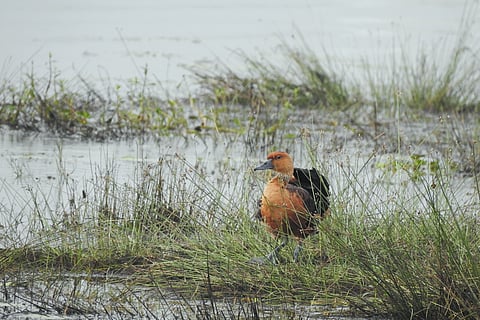

The sky is a beautiful lilac-orange and its reflection on the water, vivid and faithful. A flock of spot-billed pelicans takes an elegant buoyant flight, criss-crossing the scenery. The sound of the curious common kingfisher is heard. The fulvous whistling duck ambles around looking for food. There’s fresh greenery all around. This is what you will experience everyday if you happen to live near a wetland.
Known as the kidneys of the world, wetlands are nature’s supermarkets that are hidden in plain sight. The wetlands in Tamil Nadu comprise of lakes, ponds, reservoirs, marshes and seasonally waterlogged spaces. Over the years, the wetlands have shrunk and dwindled in numbers but we’ve somehow failed to recognise their importance.
According to the Tamil Nadu State Wetland Authority, 24,684 wetlands have been mapped, that include natural and human-made inland and coastal wetlands. The state also has one internationally recognised Ramsar Site at Point Calimere, also known as Kodiakkarai, located in Nagapattinam (A Ramsar Site is a recognised site of international importance for conservation and sustainable use). The 38,500-hectare area is very rich in biodiversity with mangroves, salt swamps and reserve forests.
We might have seen many wetlands, but might not have recognised their presence. The year 2020 brought us closer to natural landscapes and wildlife and the conversations about wetlands have fortunately increased. Wetlands are essential for clean water, are part of the network for migrating bird species and provide unique habitats for flora and fauna. World Wetlands Day is celebrated every year on February 2 to reaffirm the protection and love for wetlands. The theme for the year 2021 is Wetlands and Water.
The ecoservices of wetlands cannot be undermined. Expounding the connection between wetlands and water, Professor Dr Kurian Joseph from Centre for Environmental Studies, Anna University shares, “There are three main links – wetlands manage the water by preventing flooding and droughts, they purify the water and maintain water quality thereby enabling a good habitat for aquatic species and they provide economic value with occupations like fishery and tourism.”
Spot-billed pelicans in a wetland. Image courtesy: Care Earth Trust
One of the major threats to Tamil Nadu’s wetlands is the dumping of waste. “Because of the lack of awareness about the ecoservices of wetlands, people start dumping waste there and wetlands become wastelands. After several years, the wastelands get converted into construction sites and we face scenarios like flooding. With improved waste separation at source and better waste management we can stop the wetlands from being polluted with garbage,” adds Dr. Kurian.
Care Earth Trust is an organisation that has been involved in wetland research, conservation and science-based restoration for over two decades. The members have drafted a Comprehensive Management Plan for the Pallikaranai Marsh in Chennai and have been involved in other wetland restoration projects that include Puduthangal and Thazhambur. They also drafted Management Plans for 13 Wetland Bird Sanctuaries in Tamil Nadu counting Koonthankulam and Karikili.
About the important Pallikaranai wetland area, the team says, “The marsh has a recorded 167 species of birds, 100 species of fish, 141 species of plants (including 29 species of native grasses). The area acts like a sponge soaking up water during peak rainfall and releases it slowly during dry spells. The Pallikaranai marsh also plays an important role in groundwater recharge, especially for South Chennai aquifer that runs from the south of Adyar right up to Kovalam.”
What was once spread over 5,500 hectares according to a 1965 survey, the urban marshland has been truncated to a mere 300 hectares today, due to the fabrication of concrete structures like houses and workspaces and dumping of waste. Urban wetlands like Pallikaranai are important because by 2050 the urban population is projected to increase to 68% as people migrate for jobs. The stress of urbanisation on urban wetlands will be immense, as housing and industries burgeon. The number of cities in Asia is expected to increase and Tamil Nadu is the third most urbanised state of India. What if unchecked human activities evanesce these wetlands?
Conservationists say many livelihoods that depend on these wetlands will be erased. There will be an increase in urban flooding and drought. The quality of water will also depreciate and the winged beauties from far and wide won’t visit the landscape. It will take a huge toll on the mental well-being of all residents too.
“Restoration of wetlands takes a lot of effort and a 100% restoration is not possible. But, when we remove the bulk of waste and allow nature to take care of the rest, we’ll be surprised about nature’s potential to repair itself,” Dr. Kurian opines with optimism.
Therefore, wetland management is very important. Care Earth Trust states that Tamil Nadu has identified 140 wetlands as priority sites and their management strategies are being evolved. The responsibility of maintaining Tamil Nadu’s wetlands falls on us all. The wise use of wetlands is our ethical and moral obligation.